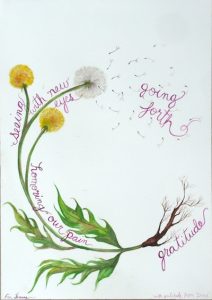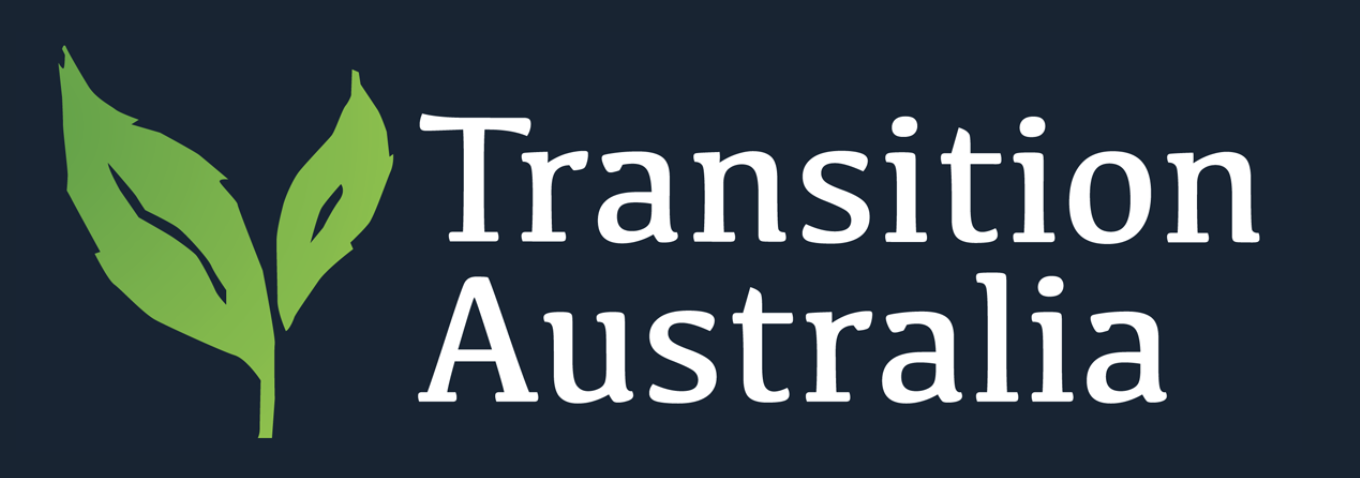The Transition movement from the very beginning in 2006 has been deeply influenced by The Work That Reconnects, based on the teachings and practice of Joanna Macy. The Work That Reconnects unfolds as a spiral journey through four stages: Coming from Gratitude, Honoring our Pain for the World, Seeing with New/Ancient Eyes, and Going Forth.

image by Dori Midnight
Each of these stages leads naturally to the next. The journey helps us experience first hand that we are larger, stronger, more creative – and more deeply interconnected – than we knew.
So often in our culture it is considered socially unacceptable to express strong feelings about the devastation we humans are causing to our beautiful planet. And yet the processes offered in The Work That Reconnects have shown over and over again the power of safely honouring strong feelings, and thus feeling liberated to act with courage and creativity.
An example of this process was demonstrated when, on 24 April 2020, 1000 people gathered via Zoom to take part in an “Anxiety to Empowerment” Council conducted by Jonathan Gustin, with Joanna Macy at age 90 offering her wisdom.
I recently sat down to watch the recording of this event, and found myself immersed in this extraordinary two-hour process, with people from all around the planet, all in pandemic isolation, first sharing their grief: “At this time of great crisis, what is in my heart?” and then pondering: “Is there anything about the current situation that brings a sense of opportunity, of gratitude, of humanity 2.0?” A powerful and wholly constructive process.
Kit Shepherd offers some thoughtful and practical reflections on this question of grief as a gateway to action:
Many advice columns and personal development gurus talk about managing emotions. And finding a place to express them is a common first step. Easier said than done! And expressing emotions, genuinely and deeply, is mostly messy, often loud and frequently off-putting to the by-stander. For who is to be the Other, who will allow – even tolerate – someone’s heartfelt sobbing, quivering terror or accusatory raging, without feeling uncomfortable?
We don’t allow those around us to express their feelings; it’s disruptive and often embarrassing, in social settings. But there are more ‘intimate’ situations where this need to let our emotions overflow might be thought more welcome. But watch, when someone pauses with tears in their eyes and quivering lips, see how their ‘partner’ gets anxious and tries to stop them crying….in the nicest of ways (arm round shoulder, ‘there, there’ etc) Our anxiety as listeners gets in the way of allowing our friends the space to let their feelings well up and find full expression. So our unresolved feelings linger and stagnate, getting in the way of moving forward in our lives.
My lengthy involvement with a counselling network has taught me useful processes and allowed me to dive in to the rich and turbulent life of the emotions, without upsetting anyone else. Let me share some of what I’ve learned.
A confidential space is chosen and permission is given, to let the feelings flow; in fact that is the main approach in this method. Don’t simply allow the full, cathartic expression of feelings, but encourage and prolong it! Cry your way through feelings that have deep and early origins. But to get to the tears (or laughter) may not be easy, unusual as it is, to do so. The listener’s generous attitude of goodwill and delight while simply and gently offering the space for their partner to speak, is the main tool. Giving complete attention, and not saying anything, not interrupting, not questioning, makes it possible for things to be spoken and feelings discovered, that might otherwise need to be held back.
So it is with grief, and the climate emergency. Why aren’t we all walking around doubled-over with sobbing, for the fate of the world? There is much in the world situation that presses our feeling-buttons.
Of course to function in our day-to-day lives we need to be able to control the tap that allows our emotions to flow, to draw our attention away from painful memories or incidents that upset us. But without taking those ‘tucked-away’ feelings to a safe space later, to process with a kind ‘listening partner’, they will remain in us like icebergs, waiting to disturb our equilibrium when we’re least expecting it.
We are well-practiced at keeping the lid on our inner lives, so much so that some of us lose the capacity to recognise that we’re feeling anything. And often our feelings simply hijack our ability to think; we get carried away and make hasty, ill-considered decisions or act impulsively.
So, I advocate letting it all hang out – in a Listening Partnership session. Find a listening partner (someone you trust and who can give good attention), and let them read this article. Give each other equal time (use a timer, so it’s all kept equal), and know that tapping into the emotional world through telling of an incident or a struggle, is the beginning of healing.
Be pleased (and quietly thankful) when your buddy sobs, laughs, shakes, yawns expansively or shouts (into a cushion if you live at close-quarters with neighbours); encourage them to keep going until the end of their allotted time. These are healing processes and are more important than the ‘story’ being told. And at the end of their session, bring their attention back to their immediate surrounds with a question about what they see, hear, or have recently eaten or noticed, for example. It’s important that the session ends cleanly and life can then proceed to the next engagement.
What happens next? After the knotted feelings have been unravelled, the mind is freer, more present and fluid, more able to think clearly and get on with daily life. And with sharper thinking, we can plan our lives, set goals, spot the needs of others and work toward having life and the world the way we think it should be.
So in this way, grief (and any feeling that is recognised, welcomed and set free through this listening partnership arrangement) can be a gateway to action.
Kit Shepherd, Convenor, Transition Bondi, April 2020 with introduction by Mary Stringer
You can watch the “Anxiety to Empowerment” Council here: https://www.youtube.com/watch?v=CVB2P8wSAGA#action=share
and read more here: https://www.purposeguides.org/free-webinar-pandemic-as-practice-1#unique-id
See also https://workthatreconnects.org/ and https://workthatreconnects.org/spiral/

